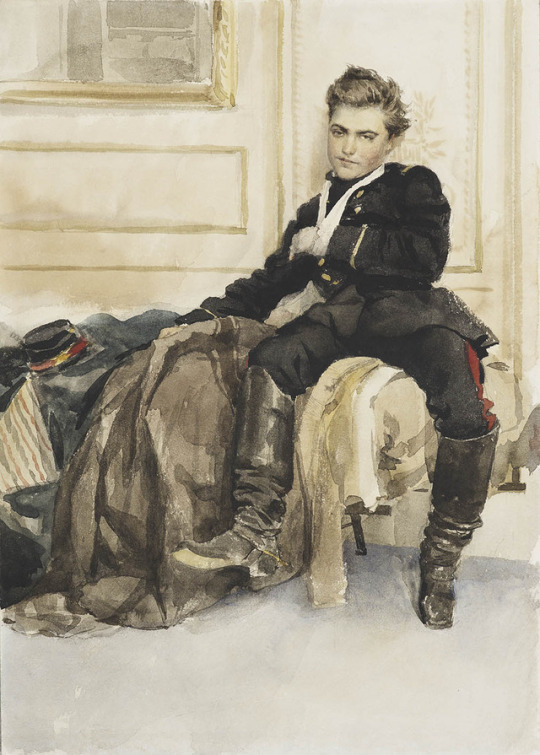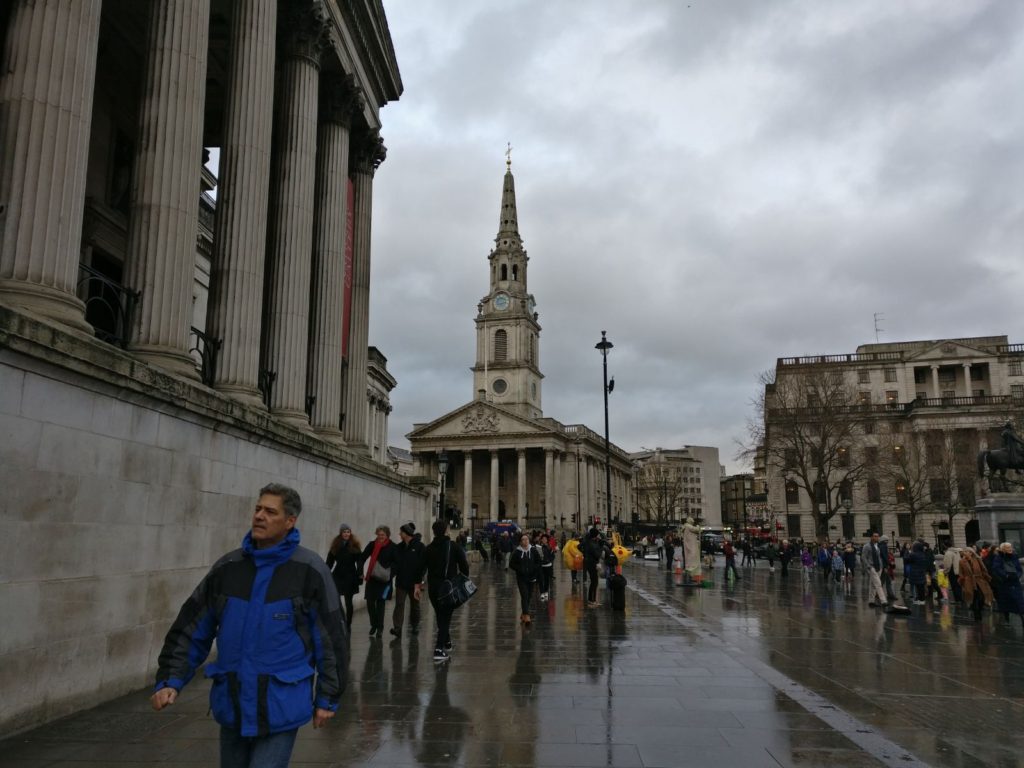The Impressionists in London: French Artists in Exile 1870-1904 & Monochrome: Painting in Black and White
The Impressionists in London: French Artists in Exile 1870-1904, Tate Britain, until 7th May 2018
The first room of this vast exhibition focusses on the Franco-Prussian and Civil War in Paris, the reason many Impressionist artists fled the city in the 1870s. Art created during any time of conflict has the ability to communicate something significant at face value, giving an immediate assessment of humankind that is often stark and emotive. Paintings, drawing and photographs that document the horrors of war and the devastating aftermath are on display here. Lithographs by Edouard Manet on the subject of Civil War and photographs by Charles Soulier drive home a message of futility, the carnage and waste of both human life and civilisation. James Tissot‘s Wounded Soldier (c.1870) shows a young man who has fought and been injured. Draped on the end of a bed strewn with clothes, there is an immediacy that is reflected in his directis gaze. His scruffy hair and ruddy cheeks give the impression of youth. But in contrast to the boyish features his piercing gaze tells us something of the horrors he has seen. I think his face expresses something between contempt and nonchalance, as if to ask us what it was all for, what was the point? In the war with Prussia both sides lost 100,000 men in six weeks.
Tissot and a number of Impressionists came to London during and after the conflicts, either temporarily or on a long-term basis. Many immersed themselves in the culture and communities London had to offer, and the art that they created provide uniquely English views through French eyes. While some of the examples in the exhibition here show London’s famous smog and it’s generally murky personality, for the most part the focus is on light and energy of both city and suburban life. In a room entitled Through Outsiders’ Eyes, Leicester Square by Monet is immediately eye catching. It is hard to believe that it was painted in 1901, when it is so vibrant and modern in comparison to what was being produced contemporaneously in England. Painters like John William Waterhouse and Lawrence Alma-Tadema were still churning out idealised images of Medieval or Classical themes, inspired by Shakespeare or Ancient civilisations. Monet was painting the present, inspired by what he saw before him and capturing a fleeting moment as it dissolved. Hot reds and yellows are dashed onto the canvas with energy, bursting like fireworks against the cool blue backdrop. These French artists in London around the turn of the century were interested in the here and now, and captured the city in a way that was for the most part ignored by the natives. But somehow there is something pessimistic in this painting. Perhaps Monet saw city life as the antithesis of nature, stifling and restrictive. Artificial light replaces the sun, the bustling noise fills the silence and anonymity becomes the opposite of the individual.
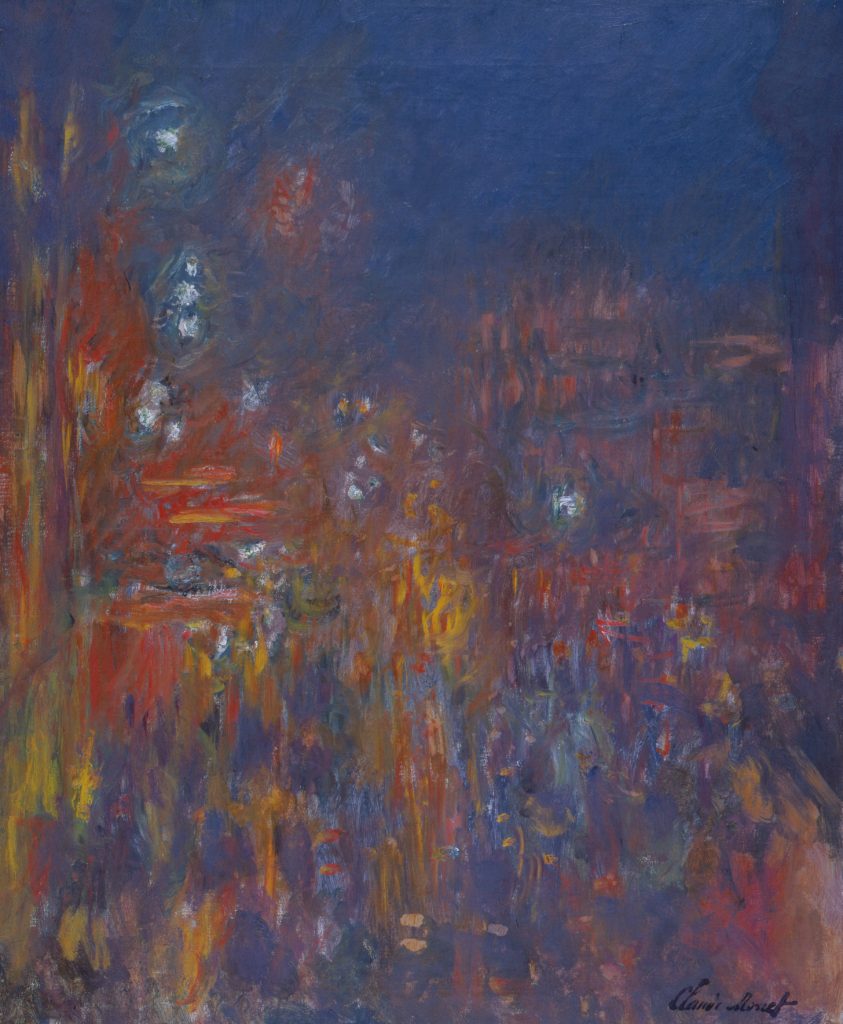
Leicester Square at Night (1901) by Claude Monet, oil on canvas, Fondation Jean et Suzanne Planque (in deposit at Musée Granet, Aix-en-Provence) Photo: © Luc Chessex
Seeing works by Guiseppe de Nittis was the highlight of this exhibition for me, as I am ashamed to say that I had never heard of him before. The Italian-born painter had lived in Paris for a number of years, befriended many of the Impressionists and exhibited with them in their first show in 1874. During his short-lived career he visited London frequently and even lived there for a time, and I think his familiarity with the city comes through his paintings. The National Gallery in London (1877) depicts something more than a time a place; he gets across that singular feeling of being in London. As sunlight struggles to break through the temperamental English clouds, we get a glimpse of the clear, cool light that his paintings are so often infused with. Like the Impressionist De Nittis painted en plain air, but in a detached way he chronicles the life of the city unlike anyone else. The art critic Philippe Burty said of him that he “knows more about Paris than the Parisians themselves”, and I think the same can be said of his views of London on display here. The characterful faces, dirty classicised architecture and commotion of traffic that are synonymous with the city could not be mistaken for Paris. De Nittis captures the quintessential Englishness of London. I love the birds in the sky souring around the spire of St Martin-in-the-Fields. My friend took a photograph of almost the exact same view on the day we visited London which shows how much the city has changed in 140 years, but also how it has not.
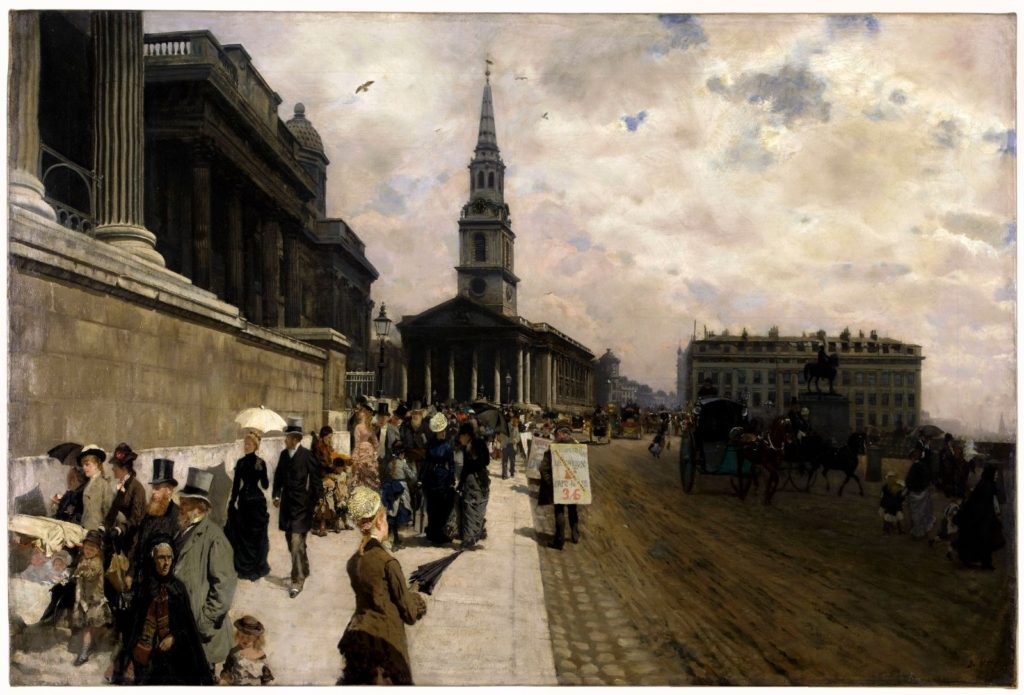
The National Gallery in London (1877) by Giuseppe de Nittis, oil on canvas, Petit Palais, Musée des Beaux-Arts de la Ville de Paris
Impressionist shows are nearly always beautiful and this is no exception. Thematic disputes aside, this vast exhibition at Tate Britain gathers a wonderful collection of objects, among which are some beautiful examples of 19th century sculpture by Carpeaux and Dalou (Hush-a-bye-Baby from 1875 is a highlight). The overarching feeling is that the artists who came to London found new challenges and subjects, and, for the most part, found inspiration here. Monet’s views of the Houses of Parliament and Westminster displayed in the second to last room are a testament to that. The famous London smog and its effect on light provided Monet with a unique subject matter, of which he said that ‘It’s the fog that gives London it’s marvellous breadth.’
I would imagine that the Impressionists were like a breath of fresh air to the sometimes stuffy and serious Victorian painters of the age. The art market certainly benefitted from their presence, and dealers such as Paul Durand-Ruel helped the artists popularity, so that they became financially successful during their time in England. On the flip side, British artists were inspired by and struck up friendships with the Impressionists staying and working in the city, forming a creative community.
Monochrome: Painting in Black and White, National Gallery, until 18th February 2018
This exhibition is the first to focus on how artists have used monochromatic versions of their work to explore and play creatively. Far from being colourless, the wide selection of objects on display give us a unique opportunity as a viewer to experience art beyond colour.
For me, the most poignant example in the show of how colour can change an image is Odalisque in Grisaille (c.1824-34) by Jean-Auguste-Dominique Ingres. Sensualism played a big part in Ingres’ works, and La Grande Odalisque (1814) in the Louvre gives a completely different experience to this later painting. The soft flesh of the nude female has been turned into cool stone. The tones and textures of the colour version has an almost audible quality. There is contrast in the silky fabrics, golden bangles and peacock feather fan against the Odalisque’s warm skin. She appears more like a sculpture of an pagan goddess here; which is ironic as Ingres caused a sensation by painting this female nude and not calling her Venus or Aphrodite as artists before him had done. Her expression is somehow more distant, she is untouchable in monochrome. The liberties Ingres has taken with anatomy seem more harsh here, there being less depth and no sense of movement to ease the discrepancies. The Grisaille painting shows just how much we rely on colour as a source of visual information.
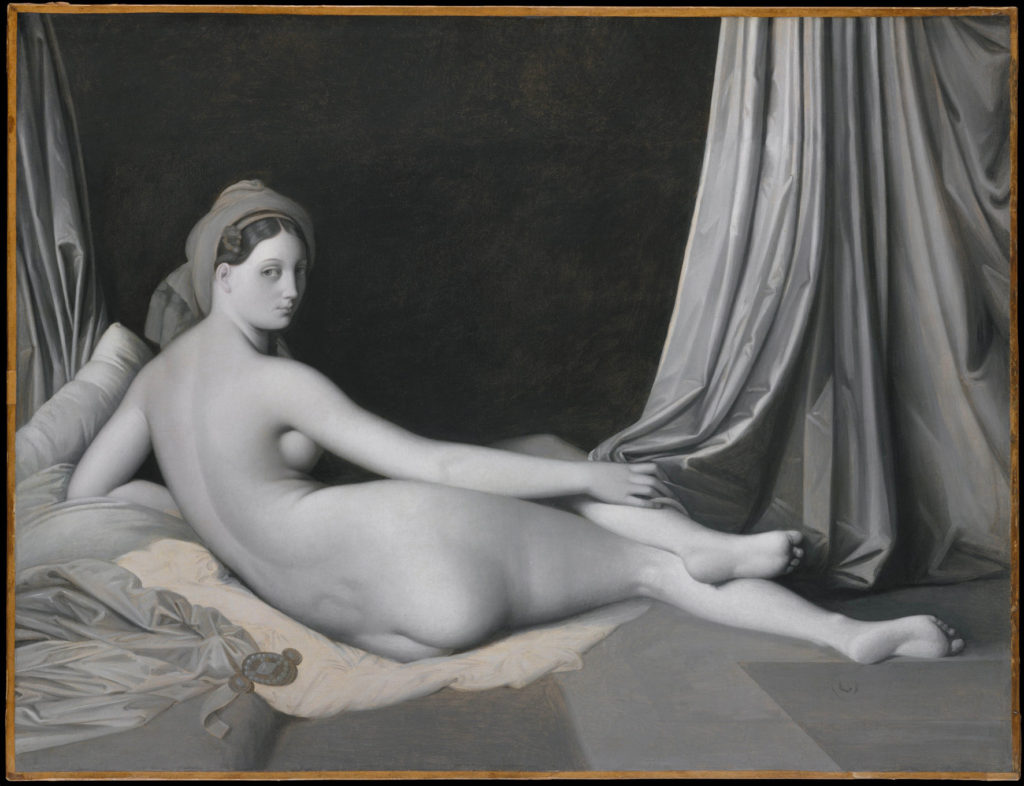
Odalisque in Grisaille (c.1824-34) by Jean-Auguste-Dominique Ingres and workshop, oil on canvas, © The Metropolitan Museum of Art/Art Resource/Scala, Florence
Jan van Eyck is an artist whose name conjures bright jewel tones and a technique that can render oil paint into any material. Yet this wonderful silverpoint of Saint Barbara (1437) reveals the high level of draughtsmanship behind all of his work. Of course the medium has dictated its lack of tonality, but there is something sacred about seeing the bare bones. The very fine detail and lines create a ghostly image, almost like an apparition. While Saint Barbara died in the 3rd century BC, the cathedral being constructed behind her is undoubtedly Gothic. It is perhaps a reference to the tower she was kept in by her father to protect her from suitors. The frame has been painted to replicate red marble, the solidity of which enhances the fragility of the drawing. It is unknown whether this was a preparatory work for a piece that was never created, but it must have served a purpose for van Eyck. Despite its small size – 41.4 × 27.8 cm – there is a great sense of perspective in the work, and it shows off the artist’s ability to work intricately on such a small scale.
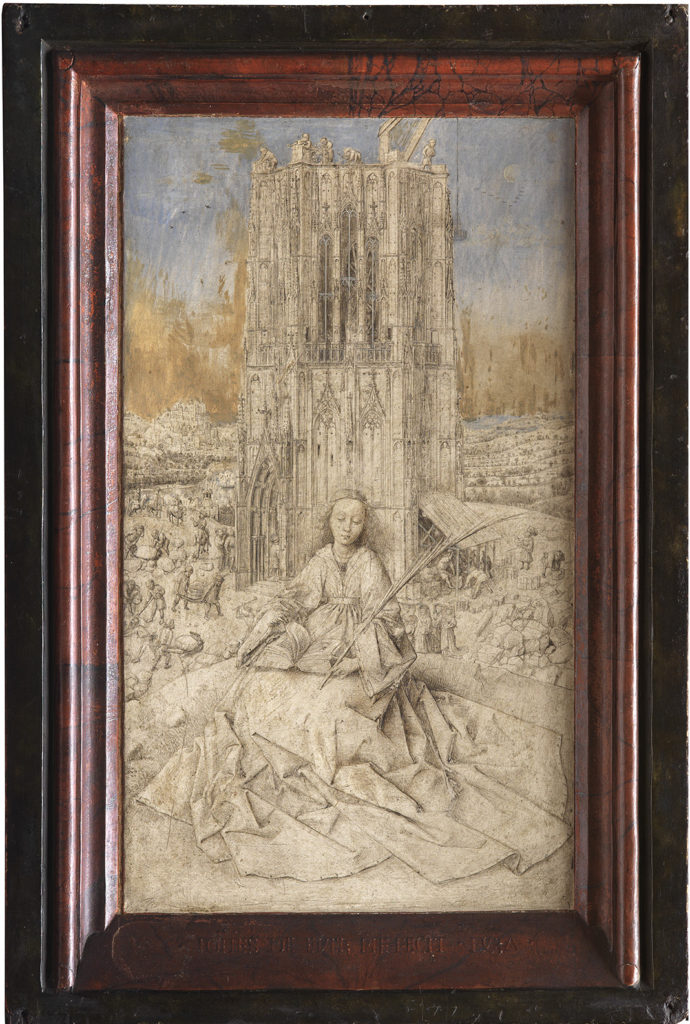
Saint Barbara (1437) by Jan van Eyck, silverpoint, india ink and oil on panel, Royal Museum of Fine Arts, Antwerp, © www.lukasweb.be‐Art in Flanders vzw, photo Hugo Maertens
Painting in monochrome gave artists a way to showcase their virtuosity and imagination, and there are a few examples of trompe l’oeil in the exhibition. Deposition (1800) by Bernardino Nocchi after Antonio Canova is so illusionistic that the paint has been transformed to marble. From a distance I thought that a Canova had been put on the wall. Nocchi forms dimension and solidity through light and shade, echoing Walter Benjamin’s mantra that colour follows form. Tonality has been exploited by the artist to become something it is not, and engage the viewer in a challenge. There would have been a competitive streak in an artist to create the most deceptive and surprising works of art, and so a reduced palette does not equate to a restricted creativity. There is much written about the theory of colours, but there is a valuable artistic and psychological aspect of art in black, white and grey.
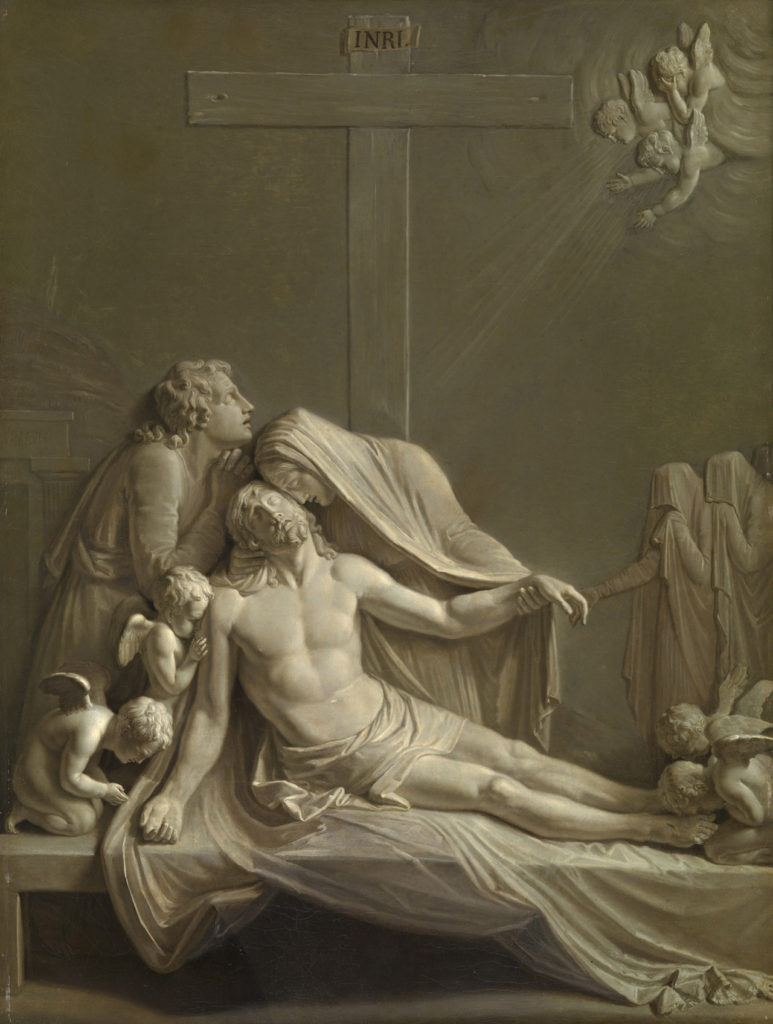
Deposition (1800) Bernardino Nocchi after Antonio Canova, oil on canvas, The Art Institute of Chicago, restricted gift of Scott, Lynda, Jonathan, and Lindsey Canel, 2013.57, © The Art Institute of Chicago/Art Resource/Scala, Florence
The juxtaposition of objects from 12th to 21st century creates a unique exploration into the technical and playful perimeters of monochromatic mediums. For Medieval sacred art, colour had deep religious connotations (and was sometimes even prohibited), but later in the Renaissance we see that artists eradicated colour to allow them to play and more fully understand their compositions. The exhibition is original and beautiful, providing a fresh perspective for the audience. It does something rare by fulfilling both a basic visual enjoyment and a higher academic level of interest. The final room contains Olafur Eliasson’s immersive installation Room for One Colour (1997), which transforms us into monochrome through the use of yellow monofrequency lamps. While being an intriguing experience and a clever end to the exhibition, I don’t recommended it if you have a headache.

